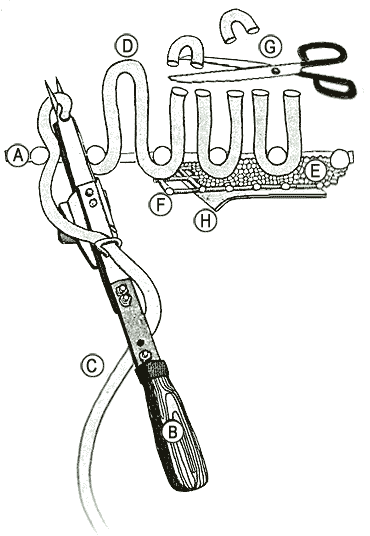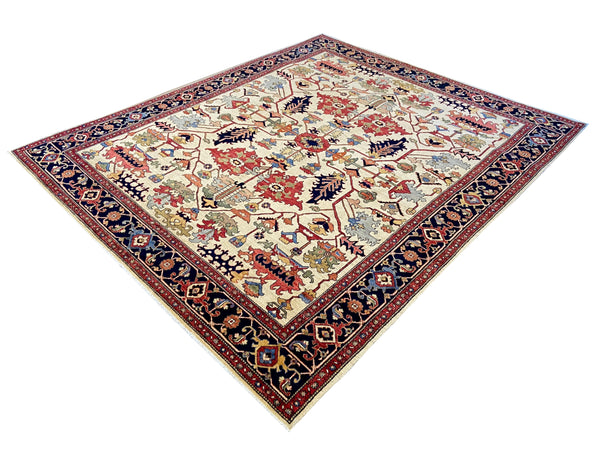Area Rug Construction
Area rugs are made in many different ways, some by hand, some by machine, the way a rug is constructed will effect its price as well as its longevity. Understanding how a rug is made can be very helpful in determining what kind of rug to buy. Below we'll discuss the most common area rug constructions as well as their pluses and minuses.
Hand Knotted:
Hand-knotting rugs is an intense labor of love whereby each knot is created by tying yarn around a warp thread. This ancient and time-honored technique of weaving is extremely intricate, time-consuming, and demands ability that most weavers can only achieve after years of training. Larger rugs often employ as many as a dozen skilled artisans working on a single rug at the same time. This process may take as few as three months and as long as one year to yield a single rug. The finer the knot, that is to say the higher the knot count, the more intricate and valuable the rug can be. Hand knotted rugs will remain as beautiful as the day they were purchased for twenty or more years even in high traffic areas when properly cared for.
Thank you to Nejad Rugs for the following diagram:

- WARP - The parallel threads running the entire length of the rug onto which the knots are tied.
- WEFT - The threads running across the width of the rug woven between all the rows of knots. These threads pass through alternate warp threads. Their job is to secure the knots in parallel lines and to strengthen the fabric.
- KNOT - The term used for a strand of wool yarn which is looped around two adjacent warp threads and then cut to form the pile (surface of carpet).
- OVERCASTING - A simple wrapping of dyed yarn along the entire length of both sides (edges) of a handmade rug.
- FRINGE - The visible continuation of the warp threads at both ends of the carpet.
- KILIM - The pileless web of warp and weft between the rug's pile and the knotted fringe. This is also the name for a rug without pile.
Shop our Online Hand Knotted Collections by Style:
- Antique & Vintage
- Tibetan
- Transitional
- Traditional
Shop Our One-of-a-Kind Collection by Size:
- NEW: 2x3-3x4
- NEW: 3x5-4x7
- NEW: 5x7-6x9
- NEW: 7x10-9x12
- NEW: 10x14 & Up
- All Runners
Hand Tufted:
Tufted rugs are a great low price alternative to a hand knotted rug. They are usually thick and comfortable to live on, they do not require a rug pad because they all ready have a protective backing, and they come in a huge range of styles, colors and patterns.
Due to their affordability, rugs of this craft are an emerging trend in home furnishing design. As with all constructions, not all are created equal, some tufted rugs are have densely packed pile made with good quality wool, some are made with loosely packed lower quality wools. Some can be prone to shedding, both when they are new and again as the latex glue in the backing begins to break down, some tufted rugs will shed for their duration (usually indicates a lower quality wool) while others will slow down as the extra fiber is worn and vacuumed away. Tufted rugs can have a life expectancy of 7-10 years under average use.
Shop Our Online collection: Hand Tufted

Diagram courtesy of Nejad Rugs
|
The hand-tufted rug looks and feels very much like a hand-knotted rug. This is because it uses the similar wool and dyes to some of the knotted rugs use. The difference is in the construction method. Instead of tying each knot by hand, the tufted rug is made with a tufting gun (B) from the back of the rug. (Rug hooking is similar but done from the front and the tops of the loops are not sheared.) This method saves a lot of time and keeps the price of the rug much lower than a knotted rug of equal size. The life span of a tufted rug is much shorter because it is dependent on a latex glue (which breaks down over time) that's used to hold it all together.
CONSTRUCTION STEPS
1.) Stretch foundation cloth (A) onto loom
2.) Ink design onto this same cloth
3.) Gun tuft the wool yarn (C) from the back of the cloth as shown above (D)
4.) Finish entire design changing yarn color as needed
5.) Take rug off loom and place it face down on floor
6.) Place scrim (F) upon back and apply layer of latex (E)
7.) After latex dries, shear face (G), wash and emboss
8.) Glue (less often - sew) on the back cloth (H). (Protects floor surface from the roughness of the latex and scrim.)
9.) Sew on fringe.
Hand Hooked:
Hooked rugs are constructed in the same manner as tufted rugs with one distinct difference, the yarn is punched through a canvas, but the surface is not sheared, creating a looped pile. The life expectancy is slightly shorter than tufted rugs because they tend to be less dense leaving the fibers more vulnerable to wear.
Online hand hooked collections:
- Americana
- Hand Hooked
Hand Hooked Cat's Paw in Green - See the cotton backing that indicates it is a hooked rug.
.
Hand Woven or Flat Weave:

Photo courtesy of Nejad Rugs
Also referred to as Soumak (double sided weave), Kilim (traditionally from Turkey) or Dhurrie (traditionally from India). A simple but durable rug, flat-weaves are among the most basic and beautiful of all hand-loomed floor coverings. The underlying art of flat-woven rugs is their ability to be reversed, and their suitability in nearly any setting, from the rustic to the cosmopolitan. Hand woven or flat woven rugs are known for their durability and cleanability since they do not have a backing. As with all constructions not all are created equal, look for weight and softness of the yarn. Life expectancy can be just slightly less than hand knotted rugs. Because flat weaves are less time consuming to make than hand knotted rugs, they'll also cost less to purchase. For a more detailed look at flat weaves check out our Blog post Kilims, Soumaks & Dhurries: What is a Flat Weave?
Shop our online hand woven collections:
- Classic Flat weave
- Traditional Flat weave
- Transitional Flat weave
Machine Made:
Also referred to as power loomed, or wilton weave. Some higher quality machine made rugs can last nearly as long hand knotted rugs, look for denser pile and soft backing. Machine made rugs would include broadloom or wall to wall carpet which can be cut and bound to shape and size, offering a fully customizable look for less cost than a hand made option. Life expectancy can be less than 10 years for lower quality or 20+ for high quality axminsters which have been in production in the UK since the 18th century.
Shop our online collection: Machine Made

